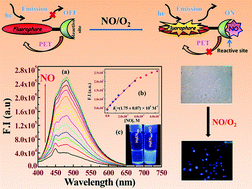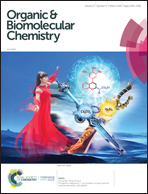A smart molecular probe for selective recognition of nitric oxide in 100% aqueous solution with cell imaging application and DFT studies†
Abstract
Herein, a simple, least-cytotoxic as well as an efficient fluorescent sensor HqEN480 was prepared from (quinolin-8-yloxy)-acetic acid ethyl ester (L1) and N,N-dimethylethylene diamine to recognize NO in 100% aqueous solution. Its marked selectivity and sensitivity towards NO, makes it a highly suitable probe for nitric oxide under in vitro conditions with the possibility of in vivo monitoring of NO. Upon addition of 3.5 equivalents of NO, there is an approximately 7 fold enhancement in fluorescence intensity in aqueous solution with a corresponding Kf value of (1.75 ± 0.07) × 104 M−1. Quantum yields of HqEN480 and [HqEN480-NO] compounds are determined to be 0.04 and 0.22, respectively, using acidic quinine sulphate as a standard. In terms of the 3σ method, the LOD for nitric oxide was found to be 53 nM thus, making the probe suitable for tracking NO in biological systems.



 Please wait while we load your content...
Please wait while we load your content...